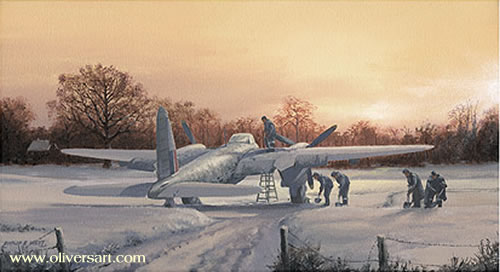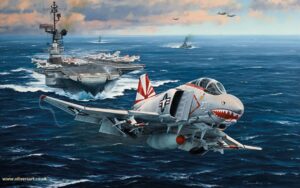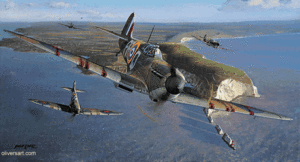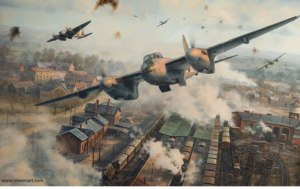Description
Very Rare Print
After a heavy overnight snowstorm, hardworking ground crew work as a team to clear the ground and prepare the aircraft for the earliest possible departure.
This is a very small edition with only 30 copies published Worldwide. This superb painting has been reproduced using special, very high quality paper, each one is double mounted (not illustrated) and they will be delivered flat.
Overall size Double Mounted approx. 24.25″ x 17”
All 30 prints are signed by Philip West and these two legendary Mosquito pilots:
Wing Commander Branse Burbridge DSO and Bar, DFC and Bar (85 Sqn. Pilot) gained his wings in 1941. Putting duty before personal feelings as a conscientious objector Branse, together with his navigator, Bill Skelton, became known as “The Night Hawk Partners”.
The two of them went on to shoot down 21 enemy aircraft – 16 during a seven-month period. The total included a Bf110 and three Ju88Gs during the night of 4-5 November 1944. Their officially credited 21 enemy aircraft destroyed made the pair the top night fighting crew in the whole of the RAF. Branse recalls, “I always tried to aim for the wings of enemy aircraft – and not the cockpit. I never wanted to kill anyone.”
The citations for their awards paid tribute to both men setting “an unsurpassed example of outstanding keenness and devotion to duty”.
Wing Commander H E Tappin DFC started flying as an NCO pilot with the RAFVR at No 3 E & RFTS run by Air Service Training at Hamble near Southampton in April 1937. He was awarded the Pilot’s Flying Badge (wings) in May 1938 and moved to 26 E & RFTS run by Marshall’s Flying School at Kidlington, near Oxford in September 1938. After completing a Flying Instructor’s Course, he started instructing in December 1938. The Kidlington school closed at the outbreak of hostilities and the staff were moved to 22 EFTS at Cambridge, where he instructed until April 1941. It was here that he taught Johnnie Johnson to fly. He was then posted to 52 OTU (Hurricane) at Debden. He had been commissioned in December 1940.
He was posted to 3 Squadron (Hurricane) at Martlesham Heath in June 1941 and became Flight Commander in March 1942. On one sortie in August 1942 whilst attacking Dieppe, the port tank of his Hurricane was shot through but he was still able to return and land safely in England, for which he was subsequently awarded the DFC. He was posted to 534 Squadron (Turbinlite) as a Hurricane Flight Commander in September 1942 and then to 157 Squadron (Mosquito) at Castle Camps and became Flight Commander in July 1943.
His next posting was to 51 OTU at Cranfield and Twinwood Farm near Bedford, as W/Cdr Flying and in January 1945 was posted to the Mediterranean to command 108 Squadron (Beaufighters) only to learn that the Squadron was to be disbanded. He spent a short period with 334 (Special Duties) Wing at Brindisi and in March 1945 was posted to Command 256 Squadron (Mosquito) with the Desert Air Force at Forli in Northern Italy. In September 1945 the Squadron moved to Egypt, from where he returned to Cambridge to continue his work with Marshall’s as a civilian pilot. He left Cambridge in January 1961 to instruct at The College of Air Training at Hamble, which had been set up by BEA and BOAC to train new pilots. He retired from Hamble in January 1972.




